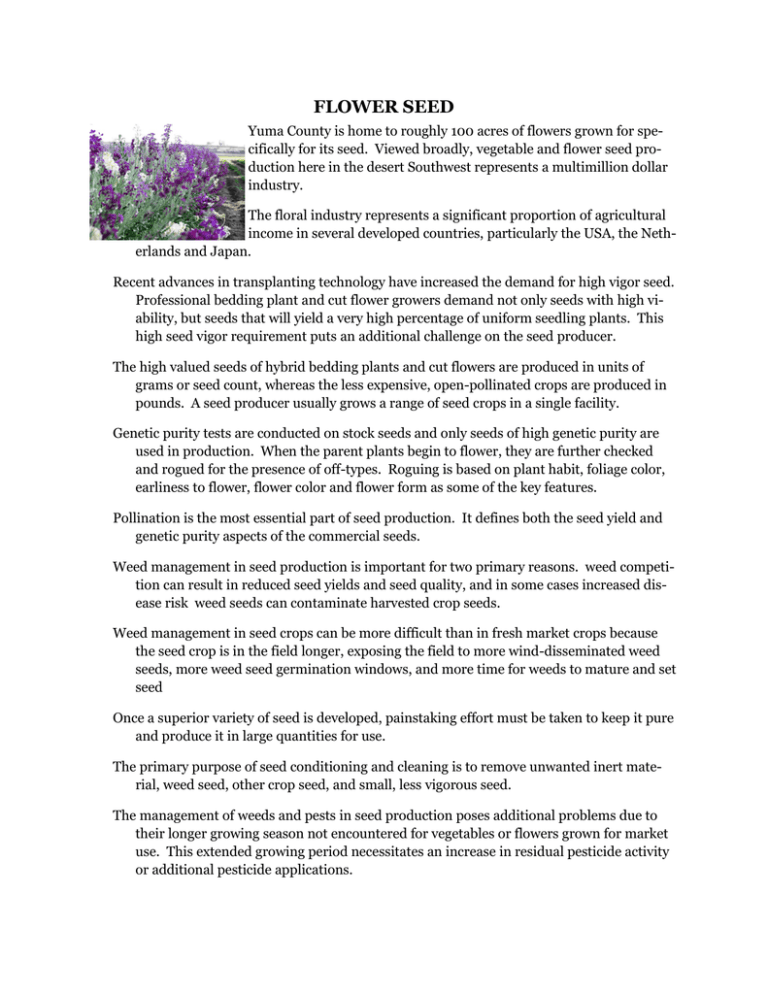FLOWER SEED
advertisement

FLOWER SEED Yuma County is home to roughly 100 acres of flowers grown for specifically for its seed. Viewed broadly, vegetable and flower seed production here in the desert Southwest represents a multimillion dollar industry. The floral industry represents a significant proportion of agricultural income in several developed countries, particularly the USA, the Netherlands and Japan. Recent advances in transplanting technology have increased the demand for high vigor seed. Professional bedding plant and cut flower growers demand not only seeds with high viability, but seeds that will yield a very high percentage of uniform seedling plants. This high seed vigor requirement puts an additional challenge on the seed producer. The high valued seeds of hybrid bedding plants and cut flowers are produced in units of grams or seed count, whereas the less expensive, open-pollinated crops are produced in pounds. A seed producer usually grows a range of seed crops in a single facility. Genetic purity tests are conducted on stock seeds and only seeds of high genetic purity are used in production. When the parent plants begin to flower, they are further checked and rogued for the presence of off-types. Roguing is based on plant habit, foliage color, earliness to flower, flower color and flower form as some of the key features. Pollination is the most essential part of seed production. It defines both the seed yield and genetic purity aspects of the commercial seeds. Weed management in seed production is important for two primary reasons. weed competition can result in reduced seed yields and seed quality, and in some cases increased disease risk weed seeds can contaminate harvested crop seeds. Weed management in seed crops can be more difficult than in fresh market crops because the seed crop is in the field longer, exposing the field to more wind-disseminated weed seeds, more weed seed germination windows, and more time for weeds to mature and set seed Once a superior variety of seed is developed, painstaking effort must be taken to keep it pure and produce it in large quantities for use. The primary purpose of seed conditioning and cleaning is to remove unwanted inert material, weed seed, other crop seed, and small, less vigorous seed. The management of weeds and pests in seed production poses additional problems due to their longer growing season not encountered for vegetables or flowers grown for market use. This extended growing period necessitates an increase in residual pesticide activity or additional pesticide applications. Seed growers are well acquainted with the characteristics of the varieties grown for seed so that they may effectively rogue out the off-types and undesirable plants at different stages of crop growth. Leaf and stem characters can easily be identified even at the seedling stage. Traditionally, seeds are harvested close to the time of seed dispersal, i.e. when the seed pods are dry and are close to being open. In the open field, pollination is done by wind or insects, depending on the specific floral type and properties of the crop species. Varieties of the same species will inter-cross with each other. To ensure varietal purity, care has to be taken that different seed crops of the same species are not grown closely together. The isolation distance requirements generally range from 1000 to 2000 feet or more, depending on whether the crop is mostly insect- or wind-pollinated. Pollination management for open pollinated crops begins with selecting production locations naturally conducive to good seed set. Optimum climactic conditions must fit the crop’s temperature and light requirements for flowering, pollen production and stigma receptivity. Insect-pollinated crops are best placed in locations where natural pollinator populations are high. Kurt Nolte is an area agriculture agent with the Yuma County Cooperative Extension. He can be reached at 928-726-3904.




